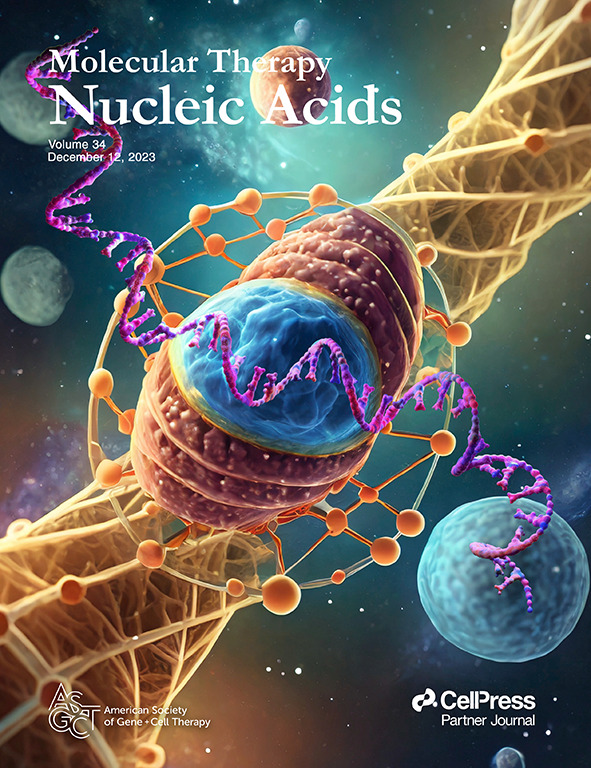Inhibition of miR-25 ameliorates cardiac and skeletal muscle dysfunction in aged mdx/utrn haploinsufficient (+/-) mice
IF 6.5
2区 医学
Q1 MEDICINE, RESEARCH & EXPERIMENTAL
引用次数: 0
Abstract
Dystrophic cardiomyopathy is a significant feature of Duchenne Muscular Dystrophy (DMD). Increased cardiomyocyte cytosolic calcium (Ca) and interstitial fibrosis are major pathophysiological hallmarks that ultimately result in cardiac dysfunction. MicroRNA-25 (miR-25) has been identified as a suppressor of both Sarcoplasmic Reticulum Calcium ATPase 2a (SERCA2a) and Mothers Against Decapentaplegic Homolog-7 (Smad7) proteins. In this study, we created a gene transfer using a miR-25 Tough Decoy (TuD) RNAs inhibitor delivered via recombinant Adeno-Associated Virus serotype 9 (AAV9) to evaluate the effect of miR-25 inhibition on cardiac and skeletal muscle function in aged dystrophin/utrophin haploinsufficient mice (), a validated transgenic murine model of DMD. We found that the intravenous delivery of AAV9 miR-25 TuD resulted in strong and stable inhibition of cardiac miR-25 levels, together with the restoration of SERCA2a and Smad7 expression. This was associated with the amelioration of cardiomyocyte interstitial fibrosis as well as recovered cardiac function. Furthermore, the direct quadricep intramuscular injection of AAV9 miR-25 TuD significantly restored skeletal muscle Smad7 expression, reduced tissue fibrosis, and enhanced skeletal muscle performance in (+/-) mice. These results imply that miR-25 TuD gene transfer may be a novel therapeutic approach to restore cardiomyocyte Ca homeostasis and abrogate tissue fibrosis in DMD.抑制 miR-25 可改善老龄 mdx/utrn 单倍体不足 (+/-) 小鼠的心脏和骨骼肌功能障碍
萎缩性心肌病是杜氏肌肉萎缩症(DMD)的一个重要特征。心肌细胞细胞质钙(Ca)增加和间质纤维化是主要的病理生理学特征,最终导致心脏功能障碍。MicroRNA-25(miR-25)已被确定为肉质网钙ATP酶2a(SERCA2a)和母亲抗截瘫同源物-7(Smad7)蛋白的抑制因子。在这项研究中,我们利用通过重组腺相关病毒血清型9(AAV9)递送的miR-25 Tough Decoy (TuD) RNAs抑制剂创建了一种基因转移方法,以评估miR-25抑制剂对老龄肌营养不良症/中营养不良症单倍体不足小鼠()的心脏和骨骼肌功能的影响,老龄肌营养不良症/中营养不良症单倍体不足小鼠是一种有效的DMD转基因小鼠模型。我们发现,静脉注射 AAV9 miR-25 TuD 能强烈而稳定地抑制心脏 miR-25 水平,同时恢复 SERCA2a 和 Smad7 的表达。这与心肌细胞间质纤维化的改善和心脏功能的恢复有关。此外,直接向小鼠四肢肌肉注射 AAV9 miR-25 TuD 能显著恢复骨骼肌 Smad7 的表达,减少组织纤维化,并提高(+/-)小鼠骨骼肌的性能。这些结果表明,miR-25 TuD 基因转移可能是恢复 DMD 心肌细胞钙稳态和减轻组织纤维化的一种新型治疗方法。
本文章由计算机程序翻译,如有差异,请以英文原文为准。
求助全文
约1分钟内获得全文
求助全文
来源期刊

Molecular Therapy. Nucleic Acids
MEDICINE, RESEARCH & EXPERIMENTAL-
CiteScore
15.40
自引率
1.10%
发文量
336
审稿时长
20 weeks
期刊介绍:
Molecular Therapy Nucleic Acids is an international, open-access journal that publishes high-quality research in nucleic-acid-based therapeutics to treat and correct genetic and acquired diseases. It is the official journal of the American Society of Gene & Cell Therapy and is built upon the success of Molecular Therapy. The journal focuses on gene- and oligonucleotide-based therapies and publishes peer-reviewed research, reviews, and commentaries. Its impact factor for 2022 is 8.8. The subject areas covered include the development of therapeutics based on nucleic acids and their derivatives, vector development for RNA-based therapeutics delivery, utilization of gene-modifying agents like Zn finger nucleases and triplex-forming oligonucleotides, pre-clinical target validation, safety and efficacy studies, and clinical trials.
 求助内容:
求助内容: 应助结果提醒方式:
应助结果提醒方式:


